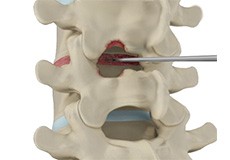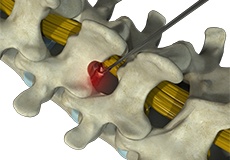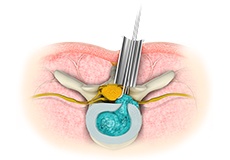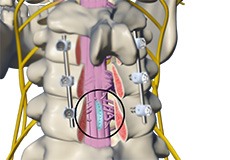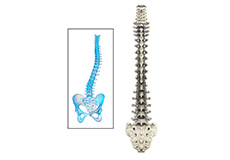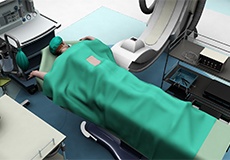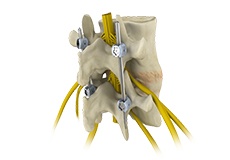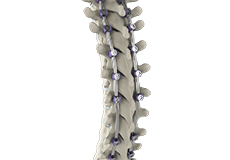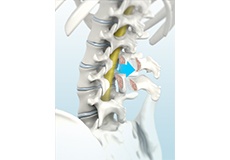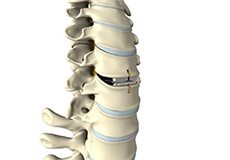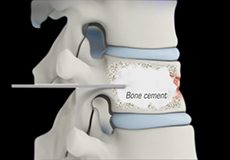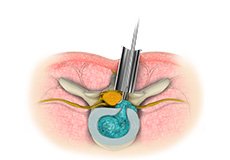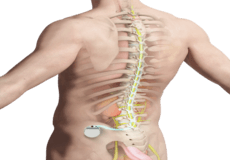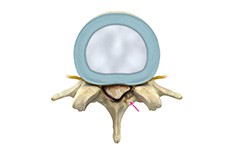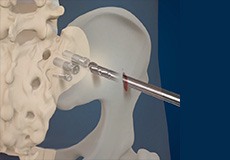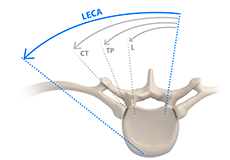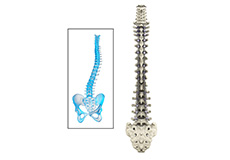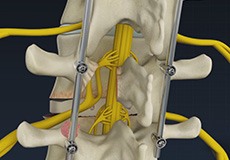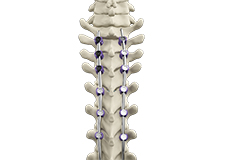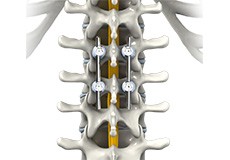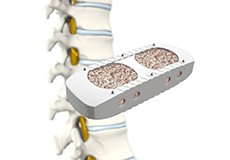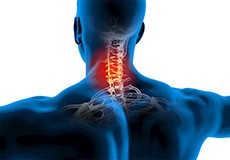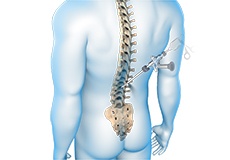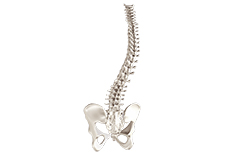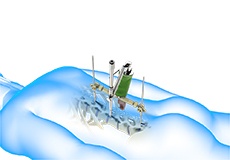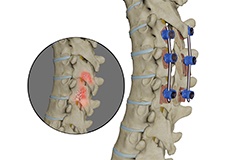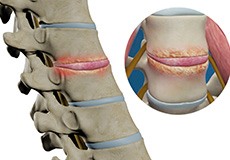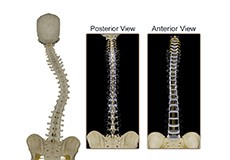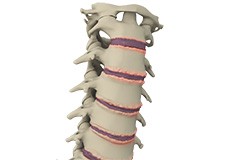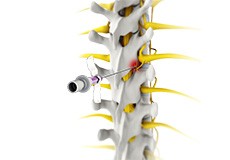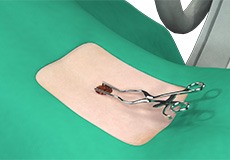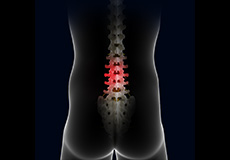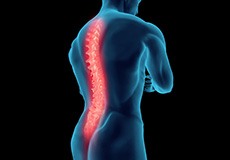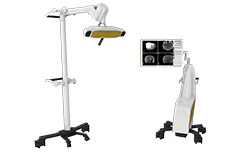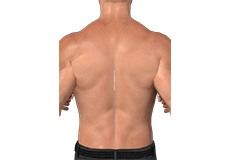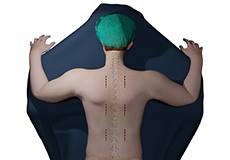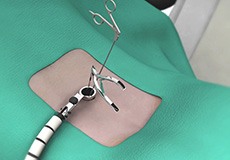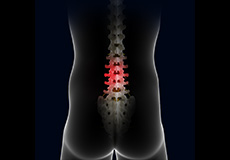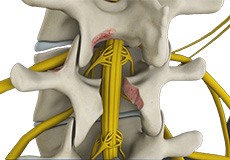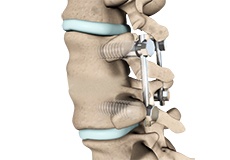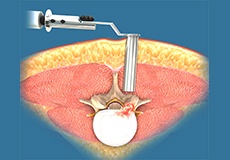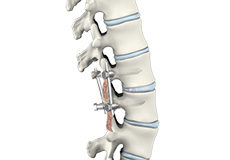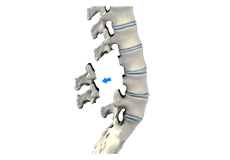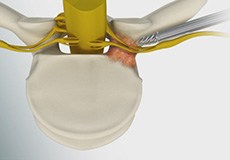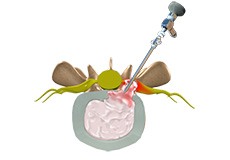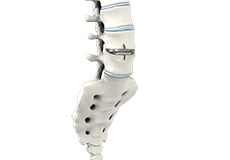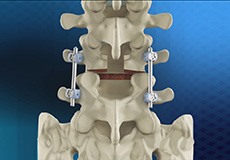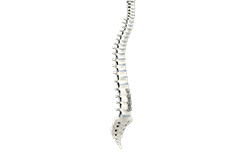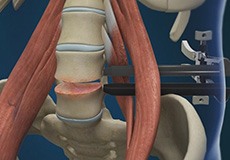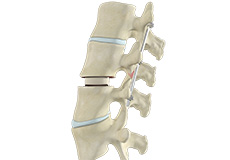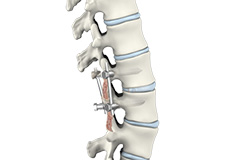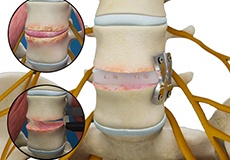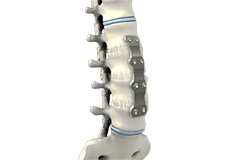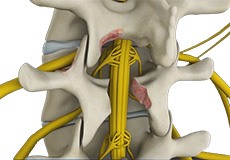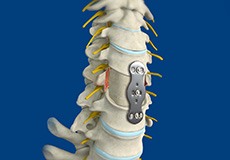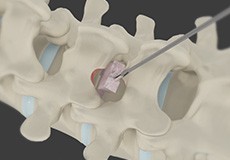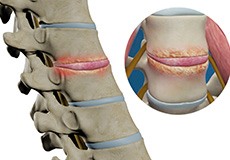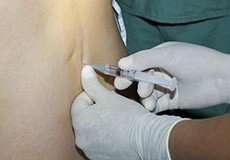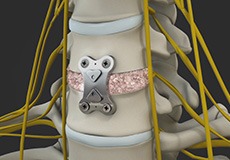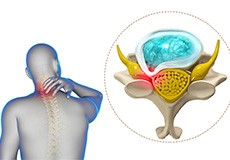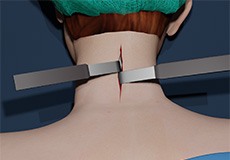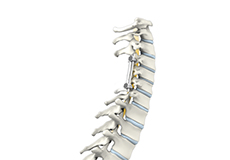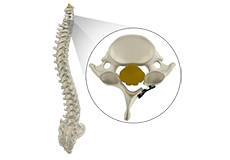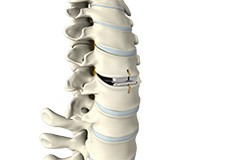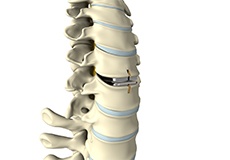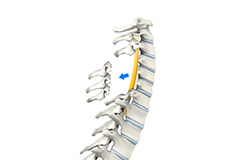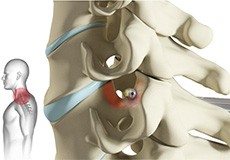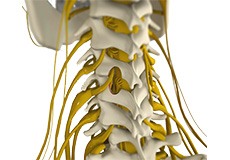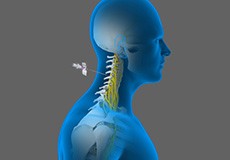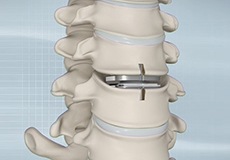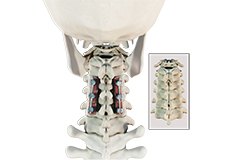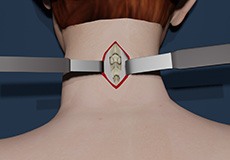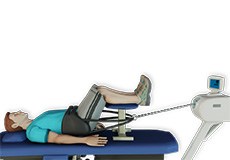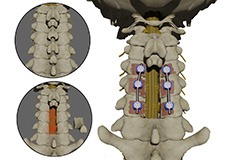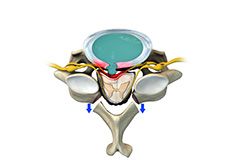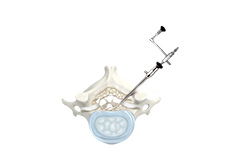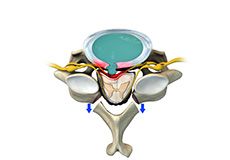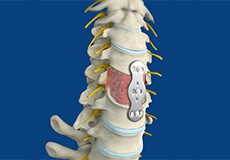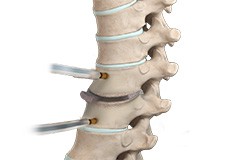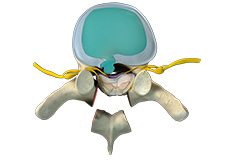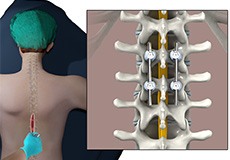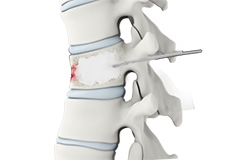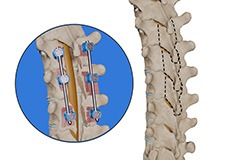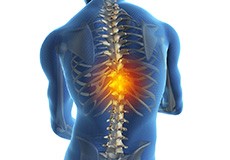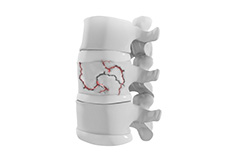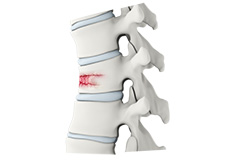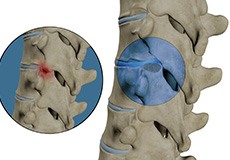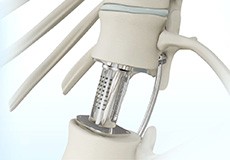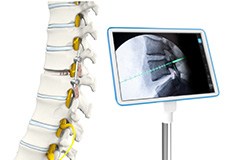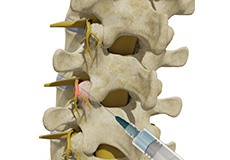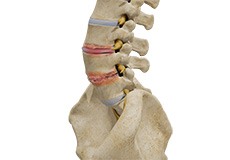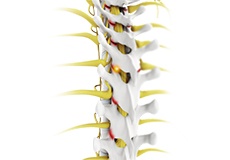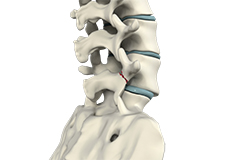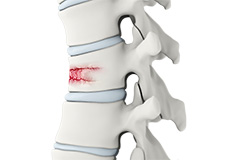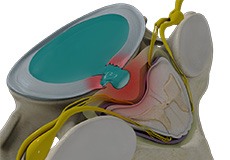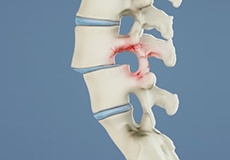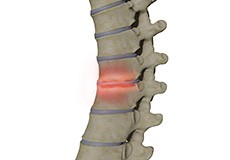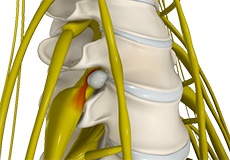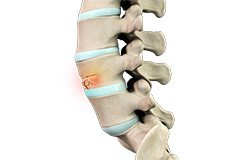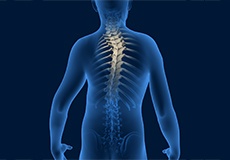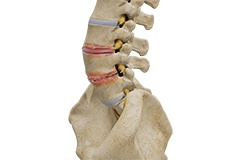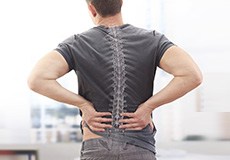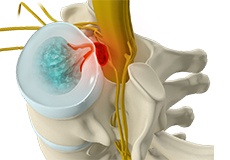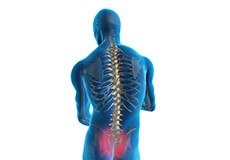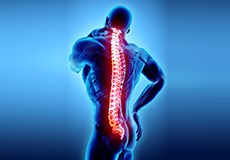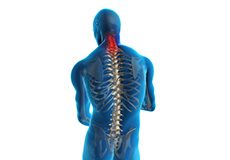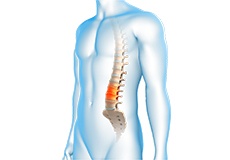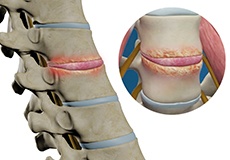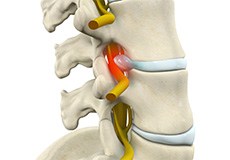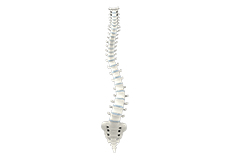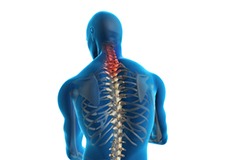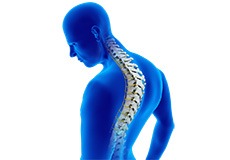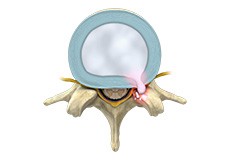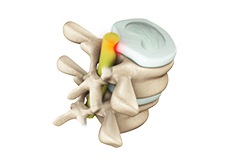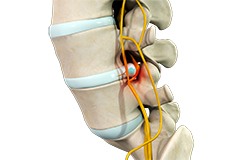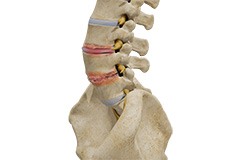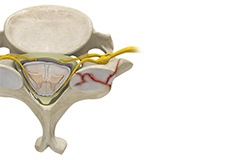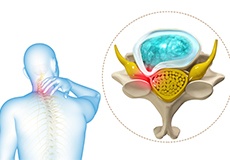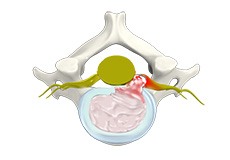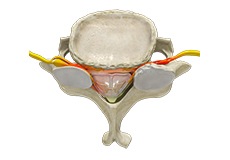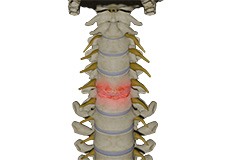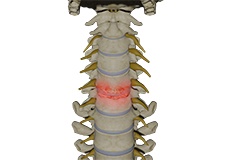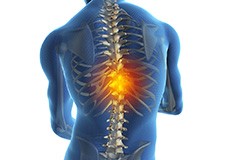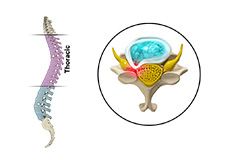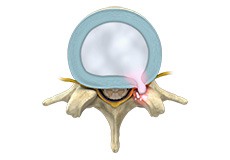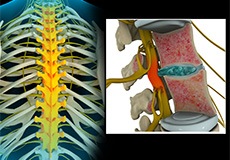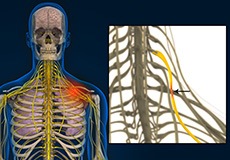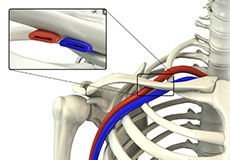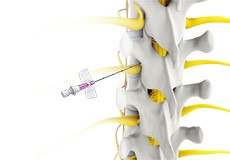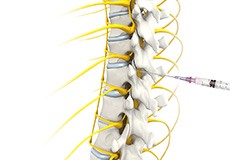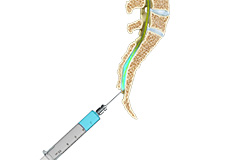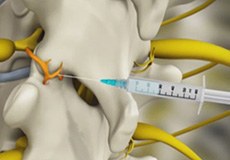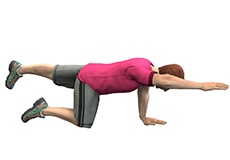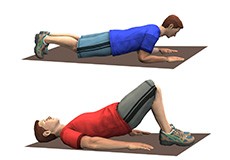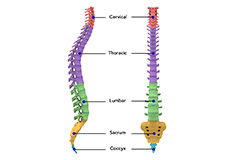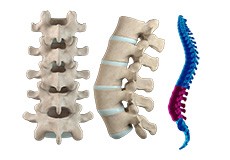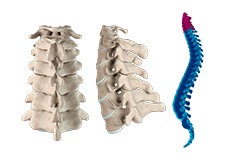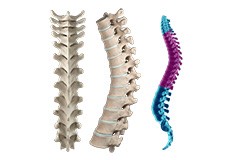Back and neck pain is common symptoms of injury, damage, deformity, or unhealthy spinal conditions. Pain may range from a mild ache to a sharp shooting pain that can spread down your arms and legs. There are many conservative and surgical treatment options that can relieve pain by targeting the symptoms or the underlying problem. Troy I. Mounts, MD is an expert orthopaedic spine surgeon who provides comprehensive care for a wide range of conditions causing back pain in California. Click on the below tabs to learn more about the treatment options.
-
Spinal Decompression
Spinal decompression is a treatment to relieve pressure on one or many “pinched nerves” in the spinal column. It can be achieved either surgically or by non-surgical methods.
-
Microdiscectomy
The spine is made up of small bony segments called vertebrae. These vertebrae are categorized into cervical or neck vertebrae, thoracic or upper back vertebrae, lumbar or lower back vertebrae, and the sacrum within the pelvis.
-
Minimally Invasive Spine Surgery
Minimally invasive spine surgery (MISS) is the latest technology available to perform spinal surgeries through small, less than one-inch-long incisions.
-
Dural Repair or Other Spinal Cord Repair
The spinal cord is covered by three layers of tissue called meninges, the outermost being the dura mater. Although it is a rare complication, the dura may get injured or tear during spinal surgery resulting in the leakage of cerebrospinal fluid (CSF), which normally surrounds the brain and spinal cord.
-
Posterior Surgery
The Spine or backbone provides stability to the upper part of our body. It helps to hold the body upright. It consists of several irregularly shaped bones, called vertebrae appearing in a straight line.
-
Revision Spinal Surgery
The goal of revision spine surgery is to reduce pain and resume normal activities. The revision spine surgery is performed in certain conditions such as re-herniation of a disc, infection, pseudoarthrosis, hardware failure, non-surgery related spine degeneration, flat back syndrome, instability, or adjacent segment degeneration.
-
Spinal Fusion
Spinal fusion is the surgical technique of combining two or more vertebrae. A fusion of the vertebrae involves the insertion of secondary bone tissue obtained either from an autograft (tissues from your own body) or allograft (tissues from another person) to enhance the bone healing process.
-
Complex Spinal Reconstruction
Complex spinal reconstruction is a major surgical procedure to correct spine deformities and associated symptoms such as pain, numbness, and instability in your back, shoulders, arms, or legs.
-
Laminectomy
Laminectomy refers to the removal or cutting of the lamina (roof) of the vertebral bones to provide space for the nerves to exit from the spine. It can also be performed to relieve the symptoms of the narrowed spinal canal known as spinal stenosis.
-
Disc Arthroplasty
Disc arthroplasty or artificial disc replacement is a spine surgery to replace a degenerated (deteriorated) disc with an artificial disc. The artificial disc is used to replace the degenerated disc to support the vertebrae while still allowing backward and forward bending, side-to-side bending, and turning.
-
Vertebroplasty
Vertebroplasty is a minimally invasive procedure performed to reduce or eliminate pain caused by a vertebral compression fracture. It stabilizes the fracture and prevents further collapse of the vertebra, averting deformity.
-
Kyphoplasty
Balloon kyphoplasty is a spine surgery that relieves back pain caused by a vertebral compression fracture. The aim of balloon kyphoplasty is to relieve pain, stabilize the fracture and restore the vertebral body height.
-
Microscopic Spine Surgery
Microscopic spine surgery is a minimally invasive surgical procedure performed using state-of-the-art technology to treat conditions pertaining to the spine.
-
Spinal Cord Stimulator
A spinal cord stimulator is a device that sends electrical impulses to the areas of the spinal cord causing pain and interferes with the transmission of pain signals to the brain. It blocks the brain's ability to sense pain in the stimulated areas, thus relieving pain without the side effects that medications can cause.
-
Degenerative Spine Surgery
Degenerative spine surgery includes surgical procedures to treat degenerative spine conditions such as disc disease and spinal stenosis that can result in the gradual deterioration of the spine with pain and loss of function.
-
Sacroiliac Joint Minimally Invasive Fusion
Sacroiliac (SI) joints are joints in the lower back region, where the sacrum and ilium bones join. Although these joints are small and have limited motion, they play an important role in connecting your spine to the pelvic bone and lower part of your body.
-
Lateral Extracavitary Approach Surgery
Many approaches have been introduced in spinal surgery to gain optimal access to the injured or diseased area, with minimal or no damage to surrounding tissues. There are three main approaches – anterior (from the front), posterior (from the back) and lateral (from the side).
-
Posterior Scoliosis Surgery
The goal of scoliosis surgery is to both reduce the abnormal curve in the spine and to prevent it from progressing further and getting worse. To achieve this, a spinal fusion is performed to fuse the vertebrae within the curve to be corrected.
-
Minimally Invasive TLIF
Transforaminal lumbar interbody fusion (TLIF) is a minimally invasive fusion of the vertebrae of the lumbar region (lower back). It is designed to provide stability to the spine and treat back and leg pain.
-
Scoliosis Surgery
Surgery for scoliosis is recommended when the spinal curvature is severe and is either worsening or is a cause of severe pain or difficulty in breathing. The surgery is aimed at rectifying the spinal curvature, stabilizing the spine and preventing it from worsening.
-
Spine Surgery in Athletes
Spine surgery is an operative procedure performed to correct spinal abnormalities. Athletes can undergo sports injuries to the spine requiring spine surgery. A sports injury is a physical trauma sustained by a direct impact, overuse, or application of greater force than the body can withstand during a sports activity.
-
XLIF - Extreme Lateral Interbody Fusion
Extreme lateral interbody fusion (XLIF) is a minimally-invasive surgery that involves the fusing of two degenerative spinal vertebrae. The procedure is conducted to relieve painful motion in the back caused by spinal disorders.
-
Treatment Options for Back and Neck Pain
Back and neck pain is common symptoms of injury, damage, deformity, or unhealthy spinal conditions. Pain may range from a mild ache to a sharp shooting pain that can spread down your arms and legs. There are many conservative and surgical treatment options that can relieve pain by targeting the symptoms or the underlying problem.
-
Endoscopic Spine Surgery
Endoscopic spine surgery is a minimally invasive spine surgery that uses specialized video cameras and instruments to remove the herniated disc through very small incisions.
-
Spine Deformity Surgery
Spine deformity can be defined as abnormality in the shape, curvature, and flexibility of the spine. When the curves are exaggerated, pronounced problems can occur such as back pain, breathing difficulties and fatigue.
-
Surgery for Scoliosis
Surgery for scoliosis is recommended when the spinal curvature is severe and is either worsening or is a cause of severe pain or difficulty in breathing. The surgery is aimed at rectifying the spinal curvature, stabilizing the spine and preventing it from worsening.
-
Robotic Spine Surgery
Robotic spine surgery is a procedure where your surgeon is assisted by a robotic system to perform surgery to the spine. Precision is very important when performing spine surgery. Robotic systems are becoming increasingly popular in the medical fraternity as it offers better precision and reduces the risk of complications associated with conventional surgery.
-
Fracture Stabilisation
A spinal fracture refers to a break in any of the bones that make up the spine. It can occur due to trauma such as a traffic accident, fall from a significant height or weakening of the bones due to osteoporosis or a tumor. The thoracic or lumbar spine (upper and lower back) are the most common locations for spinal fractures.
-
Spinal Infection Decompression
The spine is made up of bones called vertebrae which surround and protect the spinal cord. These are separated by intervertebral discs which provide cushioning between the vertebral bones. A spinal infection may affect any part of your spine including the vertebral column, intervertebral discs or the soft tissues surrounding the spine.
-
Complex Spinal Surgery
Complex spine surgery is a type of back surgery involving a fusion of six or more vertebrae. The vertebrae are a series of small interlocking bones extending from the skull to the pelvis (hip) to form your spinal column or backbone. Spinal fusion helps in forming a solid bridge of bone that stabilizes your back.
-
Anterior and Posterior Scoliosis Surgery
The goal of scoliosis surgery is to both reduce the abnormal curve in the spine and to prevent it from progressing further and getting worse. To achieve this, a spinal fusion is performed to fuse the vertebrae in the curve to be corrected.
-
Surgical Treatment for Spine Conditions
Surgical treatment is the last resort for chronic backache when other therapies do not relieve the pain. Some surgical procedures can be performed as an out-patient procedure while others may require hospital admission.
-
Radiofrequency Ablation
Radiofrequency ablation treatment is considered only after it is confirmed that the cause of back pain lies in the facet joints and this is confirmed by performing a diagnostic facet joint injection. Facet joint injection relieves pain for a short duration whereas radiofrequency ablation can keep you pain-free for a longer period of time.
-
Outpatient Spine Surgery
Outpatient spine surgery is an operative procedure that does not require an overnight stay at the hospital. It is also called ambulatory or same-day surgery. Improvement in surgical techniques, modern pain management, and rehabilitation protocols allows surgeons to perform certain operative techniques of the spine (from cervical to lumbar region), with a minimally invasive technique on an outpatient basis.
-
Complications of Spinal Surgery
The most serious complication of a herniated disc that may occur before surgery is the development of the cauda equine syndrome. It occurs when a large particle of disc material ruptures in the spinal canal.
-
Spine Comprehensive Medicine
Spine comprehensive medicine involves comprehensive care of acute or chronic neck or back injuries or conditions. It aims at minimizing your pain, making you as functional as possible and preventing future injury.
-
Computer-Assisted Spine Surgery
Computer-assisted spine surgery is an instrument tracking technology in which the surgical instruments are viewed with the help of three-dimensional images of the spine. This technology increases the accuracy and safety of the spinal procedures which cannot be achieved with traditional spinal surgical approaches.
-
Direct Lateral Interbody Fusion (DLIF)
Direct lateral interbody fusion (DLIF) is a type of lumbar interbody fusion surgery, a surgical technique involving the removal of a damaged intervertebral disc, and the insertion of a bone graft into the empty disc space created between the two adjoining vertebrae.
-
Spinal Decompression Therapy
Spinal decompression therapy involves stretching your spine using a manual or motorized traction table to help ease neck, back, or leg pain. It is a non-surgical technique to relieve pressure on your spinal discs and spinal nerves. Spinal traction is also believed to improve the supply of blood, oxygen and nutrients to the spine to promote healing.
-
Minimally Invasive Scoliosis Surgery
The goal of scoliosis surgery is to both reduce the abnormal curve in the spine and to prevent it from progressing further and getting worse. To achieve this, a spinal fusion is performed to fuse the vertebrae, in the curve to be corrected. This involves placing bone graft or bone graft substitute in the intervertebral space between the two vertebrae.
-
Minimally Invasive Spine Surgery for Spondylolisthesis
Spondylolisthesis is a condition of the spine characterized by the forward displacement of a vertebra over an underlying vertebra. A significant displacement can cause a compression of the spinal nerves resulting in pain. The two most common types of spondylolisthesis include dysplastic spondylolisthesis and isthmic spondylolisthesis.
-
Possible Complications of Spinal Surgeries
The most serious complication of a herniated disc that may occur before surgery is the development of the cauda equine syndrome. It occurs when a large particle of disc material is ruptured into the spinal canal. It occurs in the area where the nerves that control the bowels and bladder travel before they leave the spine.
One of the common symptoms of lumbar spine disorder is low back pain. It can be caused by heavy lifting, sitting or standing for a longer time, direct blow over the area, or sports such as basketball, baseball, or golf that involve sudden twisting of the lower back. The risk factors such as excess low back curvature, weak abdominal muscles, and forwardly tilted pelvis can also increase the risk of injuries. The common symptoms of lumbar spine disorders can include low back pain that radiates down to the buttocks, stiffness in the lower back, restricted movements, inability to maintain correct posture, muscle spasms, and pain that continues for a longer period. Troy I. Mounts, MD is an expert orthopaedic spine surgeon who offers highly specialized treatment for lumbar spine conditions in California. Click on the below tabs to learn more.
-
Lumbar Decompression
Lumbar decompression is a surgical procedure performed to relieve pressure over the compressed nerves in the lower spine (lumbar region).
-
Lumbar Fusion
Spinal fusion, also called arthrodesis, is a surgical technique used to join two or more vertebrae (bones) within the spine. Lumbar fusion is the procedure of fusing the vertebrae in the lumbar portion of the spine (lower back). A piece of bone, taken from other parts of the body or donated from a bone bank is transplanted between the adjacent vertebrae.
-
Minimally Invasive Lumbar Surgery
A minimally invasive technique is more beneficial for a few lumbar surgeries. Some of the common minimally invasive lumbar surgical procedures include lumbar discectomy, lumbar fusion, and lumbar laminectomy.
-
Lumbar Spinal Fusion
The surgical technique of combining two or more vertebrae is known as spinal fusion. Back pain due to abnormal motion of the vertebrae is treated by this procedure.
-
Lumbar Laminectomy
Lumbar laminectomy is a spinal surgery to relieve excess pressure on the spinal cord or nerves within the spinal canal in the lumbar or lower back region. The pressure may be caused by bony overgrowths, herniated discs, injury, tumors, or narrowing of the spinal canal resulting in painful symptoms affecting a person’s ability to perform normal day to day activities.
-
Lumbar Foraminotomy
A lumbar foraminotomy is a surgical procedure that decompresses the spinal nerves by removing bone and other tissues that obstruct the neural foramen.
-
Lumbar Microdiscectomy
Microdiscectomy is a surgical procedure employed to relieve the pressure over the spinal cord and/or nerve roots, caused by a ruptured (herniated) intervertebral disc. A herniated disc, common in the lower back (lumbar spine) occurs when the inner gelatinous substance of the disc escapes through a tear in the outer, fibrous ring (annulus fibrosis).
-
Lumbar Artificial Disc Replacement
Lumbar artificial disc replacement is a surgical procedure employed to remove and replace a damaged or worn out disc in the lumbar or lower part of your spine that has become painful and debilitating with an artificial or synthetic disc.
-
Posterior Lumbar Interbody Fusion (PLIF)
A posterior lumbar interbody fusion (PLIF) is a surgical technique that involves correction of the spinal problems at the base of the spine by placing bone graft between two vertebrae.
-
Anterior Lumbar Interbody Fusion
Anterior lumbar interbody fusion (ALIF) is a surgery performed to correct spinal problems in the lower back. The surgery can be implemented either as an open surgery or minimally invasive technique.
-
Lumbar Discectomy
A lumbar discectomy is a surgical procedure performed to treat a herniated or ruptured disc and relieve pressure on the spinal nerves.
-
Transforaminal Lumbar Interbody Fusion (TLIF)
Transforaminal lumbar interbody fusion (TLIF) is a type of spinal fusion procedure in which bone graft is placed between the affected vertebrae in the lower back (lumbar) region through an incision on the patient’s back.
-
Lumbar Interbody Fusion
Lumbar interbody fusion (LIF) surgery is a surgical technique that involves the removal of a damaged intervertebral disc and the insertion of a bone graft into the disc space created between the two adjoining vertebrae.
-
Lateral Lumbar Interbody Fusion
The back is made up of a number of small bones called vertebrae. Cushioning discs present between the vertebrae act as shock absorbers. The vertebral column allows the cylindrical bundle of nerve fibers called the spinal cord to pass through the entire column length and branch out to the various parts of the body.
-
Lumbar Corpectomy and Fusion
Lumbar corpectomy and fusion is a surgical technique performed to remove the vertebral bone or disc material between the vertebrae to alleviate pressure on the spinal cord and spinal nerves (decompression) in the lumbar (lower back) region.
-
Minimally Invasive Lumbar Discectomy
Lumbar discectomy is a spinal surgery that involves the removal of the damaged intervertebral disc(s) to relieve pressure on the spinal nerves (decompression) in the lumbar (lower back) region, which forms the lower portion of the spine and comprises of five vertebrae (L1-L5).
-
Anterior Lumbar Corpectomy and Fusion
Anterior Lumbar Corpectomy and Fusion is a surgical technique performed to remove the vertebral bone or disc material between the vertebrae to alleviate pressure on the spinal cord and spinal nerves (decompression) in the lumbar (lower back) region.+
-
Minimally Invasive Lumbar Decompression
Minimally invasive lumbar decompression or mild® is a procedure developed by Vertos Medical to treat lumbar spinal stenosis by relieving pressure on the spinal nerves.
-
Minimally Invasive Lumbar Fusion
A minimally invasive lumbar fusion technique is used to treat fractured vertebra, lumbar instability, spine deformities – scoliosis or kyphosis, cervical disc hernias, tumors, back pain, and failed back syndrome.
-
Lower Back Pain Surgery
Lower back pain can be disabling; however, most cases heal with time (2-12 weeks) and with conservative therapy. However, surgery is suggested when symptoms persist and begin to affect your daily activities.
-
In-Office Lumbar Injections
In-office lumbar injections are steroid shots administered to you in your physician’s clinical or office setting to relieve low back pain. These shots involve injecting a local anesthetic and an anti-inflammatory steroid into the lumbar (lower back) area of your spine.
The first 7 vertebral bones of the spinal column form the cervical spine in the neck region. The neck bears the weight of the head, allows a significant amount of movement, and is less protected than other parts of the spine. All these factors make the neck more susceptible to injury or other painful disorders. Troy I. Mounts, MD is an expert orthopaedic spine surgeon who offers highly specialized care and treatment for neck pain and other cervical spine conditions in California. Click on the below tabs to learn more.
-
Anterior Cervical Discectomy with Fusion
Anterior cervical discectomy with fusion is an operative procedure to relieve compression or pressure on nerve roots and/or the spinal cord due to a herniated disc or bone spur in the neck. The vertebra is approached from the from (anterior) of your neck.
-
Cervical Decompression
Cervical spine decompression surgery is recommended when nonsurgical methods are not indicated or when they fail to reduce symptoms.
-
Neck Surgery
Neck surgery is a surgical procedure employed for the treatment of neck pain when conservative measures such as physical rehabilitation, medications, and rest have failed to provide any relief to your neck pain.
-
Cervical Spine Fusion
Cervical spine fusion is a surgery performed to fuse weak cervical vertebrae with adjacent vertebrae to provide stability and prevent injury to the spinal cord.
-
Cervical Laminoplasty
A cervical laminoplasty is an operative procedure that involves reshaping/repositioning the bone at the neck region (cervical spine) to relieve excess pressure on the spinal nerves. It can also be performed to relieve the symptoms of the narrowed spinal canal known as spinal stenosis.
-
Cervical Disc Replacement
The cervical spine is located in the neck region and consists of seven bones arranged one on top of the other. Cushioning tissue called vertebral discs located between the vertebrae act as shock absorbers, allowing easy movement of the neck. Wear and tear and advancing age can damage these discs, leading to pain and disability.
-
Cervical Arthroplasty
Arthroplasty is a surgical procedure to restore joint function by replacing a damaged joint with an artificial joint called a prosthesis.
-
Cervical Laminectomy
Laminectomy refers to the removal or cutting of the lamina (roof) of the vertebral bones to provide space for the nerves to exit from the spine.
-
Cervical Foraminotomy
Cervical foraminotomy is a surgical procedure performed to relieve the symptoms of a pinched or compressed spinal nerve by enlarging the neural foramen, an opening for the nerve roots to exit the spine and travel through the body.
-
Cervical Microdiscectomy
Your spine consists of 24 bones called vertebrae that are arranged one above the other and separated by intervertebral discs which act as shock absorbers during activity. Your neck or cervical area is made up of seven of these vertebrae.
-
Cervical Epidurals
A cervical epidural is an injection of medication into the epidural space in the lower section of the cervical region to provide relief from pain or inflammation affecting the neck and upper back.
-
Artificial Cervical Disc Replacement
Artificial cervical disc replacement is a spine surgery to replace a degenerated (deteriorated) disc in the neck with an artificial disc. The artificial disc, like the natural healthy disc, is used to replace the degenerated disc.
-
Posterior Cervical Fusion
Posterior cervical fusion (PCF), a surgical procedure performed through the back of the neck, involves joining or fusing two or more damaged cervical vertebrae. The fusion of vertebrae is also known as arthrodesis.
-
Minimally Invasive Cervical Discectomy
A cervical discectomy or decompressive spinal procedure is an operative procedure that relieves pressure on the spinal nerves and/or spinal cord by partially or completely removing the intervertebral disc that is herniated and/or bony material (bone spur).
-
Cervical/Lumbar Traction
Excessive pressure on the spine from injury or stress may cause discs present between the vertebrae to herniate. Nerves exiting and entering the spine may become compressed by these herniated discs.
-
Posterior Cervical Decompression
Posterior cervical decompression is a surgical procedure performed through the back of the neck to relieve pressure over compressed nerves in the cervical spine region caused by inflamed spinal tissue or nerves, by removing portions of the cervical vertebrae.
-
Cervical Laminectomy and Fusion
Cervical laminectomy is a surgical procedure in which the spinal canal is made larger by removing the spinous process and the lamina in the cervical region of the spine. This reduces neck pain and relieves the pressure on the spinal cord caused by the degenerative changes in the intervertebral discs in the cervical region.
-
Posterior Cervical Microforaminotomy/Discectomy
Posterior cervical microforaminotomy/discectomy is an operative procedure that relieves pressure or compression on the nerve roots at the cervical spine.
-
Posterior Cervical Laminectomy and Fusion
Injury or wear-and-tear can cause parts of the cervical vertebrae in the neck region to compress the nerves of the spinal cord, leading to pain, numbness, or tingling in the part of the body that the nerve supplies.
-
Anterior Cervical Corpectomy and Fusion
An anterior cervical corpectomy and fusion is an operative procedure to relieve pressure on the spinal cord and spinal nerves by removing the vertebral bone and intervertebral disc material (decompression) in the cervical spine or neck.
Thoracic pain is the pain and discomfort caused due to damage to the muscles, nerves, bones, and joints of the upper and middle part of the spine. Pain in the thoracic area can vary from a dull ache to burning or sharp, stabbing pain. It may be associated with stiff muscles, muscle spasms, fatigue, weakness in the arms or legs, or difficulty sleeping. Troy I. Mounts, MD is an expert orthopaedic spine surgeon who offers highly specialized care and treatment for thoracic spine conditions in California. Click on the below tabs to learn more.
-
Thoracic Discectomy
The human spine provides support to the body allowing you to stand upright, bend, and twist. The spine can be broadly divided into the cervical, thoracic, and lumbar spine. The thoracic spine lies in the mid-back region between the neck and lower back and is protected by the rib cage.
-
Thoracic Spine Decompression
Thoracic spine decompression is a procedure to relieve pressure on the spinal nerves in the middle portion of the back. Spine decompression surgery is indicated in treating spinal stenosis. Spinal stenosis is the narrowing of the spinal canal caused by degeneration of the facet joints and the thickening of the ligaments.
-
Posterior Thoracic Fusion
Posterior thoracic fusion is a spinal fusion procedure performed through an incision on the back (posterior) of the patient in which two or more vertebrae of the thoracic spine (mid back) are joined together, eliminating any movement between them.
-
Thoracic Vertebroplasty
Osteoporosis is a “silent” disease characterized by weakening of bones, making them more susceptible to fractures (vertebral compression fractures), typically in the hip and spine. Vertebral compression fractures can also occur with a metastatic tumor, multiple myeloma, and vertebral hemangioma.
-
Thoracic Laminectomy
The vertebral column supports the back and protects the spinal cord that runs through it. The nerves that branch out from the spinal cord are also protected and pass through special passages created by each vertebral bone.
-
Thoracic Spine Revision Surgery
Revision spine surgery is performed to correct the problems of earlier spine surgery. It is considered when you do not obtain relief from pain following the initial surgery.
-
Thoracic Spine Trauma Surgery
Trauma to the spine can injure the vertebral bones as well as the spinal cord and spinal nerves. Spine trauma is a common injury and may be caused by falls, sports, the low impact falls in the elderly due to osteoporosis, assault, and motor vehicle accidents.
-
Thoracic Spine Fracture Repair Surgery
Spinal fractures occur most commonly in the thoracic (upper back) and lumbar (lower back) regions, and at the thoracolumbar junction. Fractures in these regions can occur due to injury from falls, motor vehicle accidents, violent acts and sports accidents, and also from the degeneration of bones due to old age and disease (osteoporosis and tumors).
-
Thoracic Facetectomy
The spinal cord passes through the vertebral column, which forms a bony protective cover. At the thoracic region (upper back), the spinal canal is especially narrow when compared to the neck and lower back regions, making it more susceptible to compression.
-
Thoracic Vertebrectomy
The spinal cord passes through the vertebral column, which forms a bony protective cover. However, a spinal tumor can compress the spinal cord or spinal nerves, leading to pain, loss of sensation, and/or motor function in the part of the body supplied by the compressed nerve.
-
Computer Navigated Thoracic Spine Surgery
The spine is a complex 3- dimensional structure that is interspersed with a complex lattice of delicate blood vessels and nerves. Trauma to these structures during surgery is a big concern in spinal surgery.
-
Thoracic Facet Joint Injection
Facet joints are small joints present between the vertebral bones including the vertebral bones of the thorax (upper back). The bones in these joints are covered by cartilage and a capsule filled with synovial fluid surrounds the joint reducing friction.
Pain in the back and neck are the common symptom of injury, damage, or deformity of the spine. Pain may range from a mild ache to a sharp shooting pain that can spread down your arms and legs. There are many conservative and surgical treatment options that can relieve pain by targeting the symptoms or the underlying problem. Troy I. Mounts, MD is an expert orthopaedic spine surgeon who offers highly specialized care and treatment for back pain in California. Click on the below tabs to learn more about the various conditions affecting your back and spine.
-
Spine Arthritis
Spine arthritis is a condition characterized by the inflammation, degeneration, or wearing out of cartilage in the joints of the spine. The cartilage in the spine includes the spinal discs between the vertebrae and the cartilage lining the facet joints in the back of the spine. Spinal arthritis can cause pain and stiffness in the back and neck.
-
Facet Joint Arthritis
Facet joints, also called zygapophyseal joints, are synovial joints located at the back of your spine, connecting the vertebrae together. Normally the facet joints are lined by a cartilage and a membrane of synovium.
-
Neck Pain
Common neck pain may occur from muscle strain or tension from everyday activities including poor posture, prolonged use of a computer and sleeping in an uncomfortable position.
-
Scoliosis
Scoliosis is a condition characterized by the abnormal curvature of the spine that causes a deviation to one side. It causes a physical deformity, making the spine look like the letter “C” or “S” instead of the letter “I”.
-
Spondylolysis
Spondylolysis is a stress fracture in the vertebra that may progress into spondylolisthesis, a condition where the vertebra gets displaced from the spinal column. Spondylolysis is the cause of frequent low back pain in children.
-
Spinal Fractures
Vertebral fractures result from a weakened spine caused by osteogenesis imperfecta, osteoporosis, tumor, and trauma. Osteogenesis imperfecta is a hereditary disease resulting in bone fragility. It is an autosomal dominant disorder of connective tissue that is characterized by easily fractured bones.
-
Spinal Disorders
The spine is made up of a column of small bones called vertebrae that surround and protect the spinal cord and nerves that branch out from the spinal cord. Each bone or vertebra is separated from the other by a spongy tissue called an intervertebral disc, which acts as a cushion and prevents the bones from rubbing against each other during movement.
-
Spondylolisthesis
Spondylolisthesis is the displacement of the vertebral disc from the spinal column. Outward (forward) displacement is termed as anterolisthesis and inward (backward) displacement is termed as retrolisthesis. This condition is often preceded by spondylolysis, a degenerative condition of the vertebra.
-
Spondylodiscitis
Spondylodiscitis is an infection of the intervertebral discs (between the vertebrae) along with the vertebrae (one of many small bones forming the spine). The condition is a primary infection of one or more intervertebral discs (discitis) with secondary infection of one or more vertebrae (spondylitis).
-
Disc Herniation
Disc herniation is a condition where the central nucleus pushes through the outer edge of the disc, causing a bulge that compresses the spinal nerves.
-
Spinal Compression Fractures
A compression fracture of the vertebra occurs when the bones of the spine (vertebrae) collapse. Most commonly, these fractures occur in the thoracic or the middle portion of the spine.
-
Spinal Instability
Spinal instability refers to the condition of failure of the spinal column to maintain its normal structure. Normally, the spine functions to protect and provide support to the body and its internal organs.
-
Spine Deformities
The spine or backbone provides stability to the upper part of our body. It helps to hold the body upright. It consists of a series of irregularly-shaped bones appearing in a straight line. The spine has two gentle curves, when viewed from the side and appears to be straight when viewed from the front.
-
Degenerative Disc Disease
Degenerative disc disease (DDD) refers to the gradual deterioration of the intervertebral discs between the vertebrae. DDD is a misnomer as it is not actually a disease but a condition that affects the strength, resilience and structural integrity of the intervertebral discs due to advancing age, trauma, injury, repetitive movement, improper posture or poor body mechanics.
-
Spinal Injuries at Work
Injuries at the workplace are very common and may be debilitating. Global statistics report that around 260 million non-fatal injuries occur every year around the world of which 350,000 cases may suffer death. Workplace injuries often occur because of high-risk jobs, lack of or scarcity in safety devices, lack of training, and higher numbers of manual workers.
-
Cauda Equina Syndrome
What Cauda equina syndrome is an emergency condition characterized by persistent severe lower back pain caused by the compression of a bundle of spinal nerves (cauda equina) at the end of the spinal cord (lower back and hip region).
-
Sacroiliac Joint Dysfunction
The sacrum is the triangular-shaped bone at the bottom of the spine, below the lumbar spine. The sacroiliac joint is a large joint in the body, formed by the connection of the sacrum and the right and left iliac (pelvic) bones. The sacroiliac joint acts as a shock-absorbing structure.
-
Spondyloarthropathies
Spondyloarthropathies are a group of chronic inflammatory diseases of the spine and joints. Spondyloarthropathies can occur at any age, however, they occur more often in young males.
-
Traumatic Spinal Cord Injury
A traumatic spinal cord injury is an injury from sudden physical trauma that results in a fracture, dislocation, or compression of one or more spinal vertebrae and the bruising or tearing of any part of the spinal cord or cauda equina, the bundle of nerve roots at the lower end of the spinal canal.
-
Degenerative Spinal Conditions
A degenerative condition is a continuous deterioration of a tissue or an organ in your body over time.
-
Spinal Infection
A spinal infection is described as an infection of the spine. It can occur in various locations of the spine i.e., intervertebral disc space, vertebral column, spinal canal, and nearby soft tissues.
-
Spinal Stenosis
Spinal stenosis is a condition caused by the vertebral column constricting and exerting pressure on the spinal cord or neural foramen (a bony tunnel through which a nerve exits the spinal cord).
-
Radiculopathy
Certain diseases or mechanical compression of these spinal nerves due to deformities in the vertebral column can lead to radiculopathy.
-
Adult Degenerative Scoliosis
Adult degenerative scoliosis is characterized by side to side or lateral bending of the spine in adults. Degenerative scoliosis can involve either the mid-back and/or lower back region of the spine.
-
Neck Strains and Sprains
The neck is the most flexible part of the spine and supports the weight of the head. The unique anatomical structure of the cervical vertebrae allows the free movement of the head. The neck is also composed of muscles and ligaments. Any excessive stress on the ligaments and muscles may injure or damage them.
-
Adult Kyphosis-Types and Causes
Postural kyphosis is the result of poor posture and is common in adolescents and younger adults. Slouching posture when sitting or standing tends to cause the spine to curve forward.
One of the common symptoms of lumbar spine disorder is low back pain. It can be caused by heavy lifting, sitting or standing for a longer time, direct blow over the area, or sports such as basketball, baseball, or golf that involve sudden twisting of the lower back. The risk factors such as excess low back curvature, weak abdominal muscles, and forwardly tilted pelvis can also increase the risk of injuries. The common symptoms of lumbar spine disorders can include low back pain that radiates down to the buttocks, stiffness in the lower back, restricted movements, inability to maintain correct posture, muscle spasms, and pain that continues for a longer period. Troy I. Mounts, MD is an expert orthopaedic spine surgeon who offers effective treatments for lumbar spine disorders in California. Click on the below tabs to learn more about the various conditions affecting your lumbar spine.
-
Lumbar Herniated Disc
A herniated disc is a condition in which the outer fibers (annulus) of the intervertebral disc are damaged, causing the soft inner material of the nucleus pulposus to rupture out of its space.
-
Low Back Pain
Low back pain is often a common symptom of many disease conditions and the back pain may range from simple or dull pain to sudden and sharp pain. If the pain persists for a few days, it is acute pain whereas if it continues for more than 3 months, it is considered as chronic pain.
-
Lumbar Radiculopathy
Back pain is a common condition affecting approximately 80% of the population at some point in their lives. The area usually affected is the lower back (lumbar region) as it bears most of the upper body’s weight.
-
Lumbar Stenosis
Lumbar stenosis is the compression of spinal nerves caused by the narrowing of the spinal canal. It is one of the common causes of lower back pain. Spinal stenosis can also affect the spine in the neck region.
-
Lumbar Degenerative Disc Disease
Lumbar degenerative disc disease (DDD) is a common cause of lower back pain. Over time, these natural shock absorbers wear out and degenerate. Degenerative disc disease is not actually a disease but refers to the changes in the spine that occur as a part of the normal aging process.
The first 7 vertebral bones of the spinal column form the cervical spine in the neck region. The neck bears the weight of the head, allows a significant amount of movement, and is less protected than other parts of the spine. All these factors make the neck more susceptible to injury or other painful disorders. Troy I. Mounts, MD is an expert orthopaedic spine surgeon who offers highly specialized care and treatment for neck pain and other cervical spine conditions in California. Click on the below tabs to learn more about the various conditions affecting your cervical spine.
-
Cervical Fracture
Cervical fractures are common in motor vehicle accidents, sports activities and falls. The second, sixth and seventh cervical vertebrae are frequently involved in fractures, which may injure the spinal cord.
-
Cervical Radiculopathy/Myelopathy
Disc protrusion, also called herniated disc, is a condition caused by a tear in an intervertebral disc, allowing the disc contents to bulge out.
-
Cervical Herniated Disc
Herniation of a disc is an anomalous spine condition characterized by the bulging of the inner contents of the intervertebral disc due to cracks in its outer wall. A herniated disc is commonly seen in the cervical or neck region and is called cervical herniated disc (CHD).
-
Cervical Stenosis
Cervical stenosis refers to the narrowing of the spinal canal that protects the spinal cord and its branching nerves.
-
Cervical Degenerative Disorder
Cervical degenerative disc disease (DDD) is a misnomer as it is not a disease but a condition that affects the strength, resiliency and structural integrity of the intervertebral discs due to increasing age, trauma, injury, repetitive movement, improper posture, or poor body mechanics.
-
Cervical Degenerative Disc Disease
Cervical degenerative disc disease (DDD) is a misnomer, as it is not a disease as such but a condition that affects the strength, resiliency and structural integrity of the intervertebral discs due to increasing age, trauma, injury, repetitive movement, improper posture, or poor body mechanics.
Thoracic pain is the pain and discomfort caused due to damage to the muscles, nerves, bones, and joints of the upper and middle part of the spine. Pain in the thoracic area can vary from a dull ache to burning or sharp, stabbing pain. It may be associated with stiff muscles, muscle spasms, fatigue, weakness in the arms or legs, or difficulty sleeping. Troy I. Mounts, MD is an expert orthopaedic spine surgeon who offers highly specialized care and treatment for thoracic spine conditions in California. Click on the below tabs to learn more about the various conditions affecting your thoracic spine.
-
Thoracic Pain
Thoracic pain is the pain and discomfort caused due to damage to the muscles, nerves, bones, and joints of the upper and middle part of the spine.
-
Thoracic Myelopathy
Thoracic myelopathy is a disorder resulting from severe spinal cord compression in the thoracic region. The spinal cord in this region typically gets compressed as a result of bulging or herniated discs, spinal trauma, or bone spurs causing severe pain and discomfort. Thoracic decompression surgery is one of the effective ways to treat thoracic myelopathy.
-
Thoracic Disc Herniation
Thoracic herniation disc is a condition in which the outer fibers (annulus) of the intervertebral disc are damaged causing the soft inner material of the nucleus pulposus to rupture out of its space. This condition can be extremely serious if it occurs in the thoracic spine. Thoracic disc herniation is a relatively uncommon condition.
-
Thoracic Nerve Compression
Thoracic nerve compression refers to a compressed nerve root in the thoracic region of the spine, also called the upper back.
-
Compression of Thoracic Nerve
Nerves can undergo compression or become pinched by surrounding structures as they emerge from the spine, a condition called radiculopathy. Nerve compression mostly occurs in the neck or lower back regions which have more mobility, but it can sometimes involve the upper back or thoracic region.
-
Thoracic Outlet Syndrome
When this passageway becomes compressed, the condition is termed as thoracic outlet syndrome. It generally occurs within the age group of 20 to 60 years and is more common in females than in males.
Pain in the back and neck are the common symptom of injury, damage, or deformity of the spine. Pain may range from a mild ache to a sharp shooting pain that can spread down your arms and legs. There are many conservative and surgical treatment options that can relieve pain by targeting the symptoms or the underlying problem. Troy I. Mounts, MD is an expert orthopaedic spine surgeon who offers effective nonoperative treatments for back and neck pain in California. Click on the below tabs to learn more.
-
Non-Surgical Spine Treatments
In most cases, back pain can be resolved without surgery. The conservative treatment involves the use of pain medications and other methods to reduce inflammation and restore normal function.
-
Spine Medications
Medications play an effective role in the treatment of back or neck pain. Your doctor may prescribe several medications to help reduce pain and associated symptoms that are caused by unhealthy spinal conditions or deformities.
-
Spine Injections
Spine injection is a non-surgical treatment modality recommended for the treatment of chronic back pain. Injection of certain medicinal agents relieves the pain by blocking the nerve signals between specific areas of the body and the brain.
-
Epidural Spinal Injection
Epidural spinal injection is a non-surgical treatment option utilized for relieving back pain. Spine degenerative conditions such as herniated disc, spinal stenosis and many others may induce back pain due to the compression of the associated spinal nerves.
-
Caudal Epidural Injection
The epidural cavity is the space surrounding the spinal cord, which extends from the skull to the tailbone, and consists of fat, nerves and blood vessels. Nerves in this space can be blocked by injecting an anesthetic, or a constricted nerve can be relieved of pain and inflammation by injecting a steroid medication into the epidural space.
-
Medial Branch Block Injections
A medial branch block is an injection of a local anesthetic administered near the medial branch nerves to temporarily block the pain signal carried from the facet joints of the spine to the brain. It assists your doctor in diagnosing the cause of your back pain.
-
Spine Rehabilitation
Dysfunction of the spine can be severely debilitating to one’s ability to perform activities at both home and work. Pain in the lumbar spine (lower back) is the number one reason for missed days of work, followed by the pain of the cervical spine (neck).
-
Physical Therapy for the Spine
Physical therapy is one of the foremost necessary treatment modes of recovery for back pain. A referral to physiotherapy sometimes is created by your spine surgeon.
-
Anatomy of the Spine
The spine also called the backbone, is made up of vertebral bones with cushioning intervertebral discs between them. The spine is designed to give us stability and smooth movement, as well as providing a corridor of protection for the delicate spinal cord.
-
Lumbar Spine Anatomy
The spine also called the back bone, plays a vital role in stability, smooth movement and protection of the delicate spinal cord. It is made up of bony segments called vertebra with fibrous tissue called intervertebral discs between them.
-
Cervical Spine Anatomy
The spine, also called the backbone, plays a vital role in stability, smooth movement and protection of the delicate spinal cord. It is made up of bony segments called vertebrae with fibrous tissue called intervertebral discs between them.
-
Thoracic Spine Anatomy
The thoracic spine is the central part of the spine, also called the dorsal spine, which runs from the base of the neck to the bottom of your rib cage. The thoracic spine provides the flexibility that holds the body upright and protects the organs of the chest.

